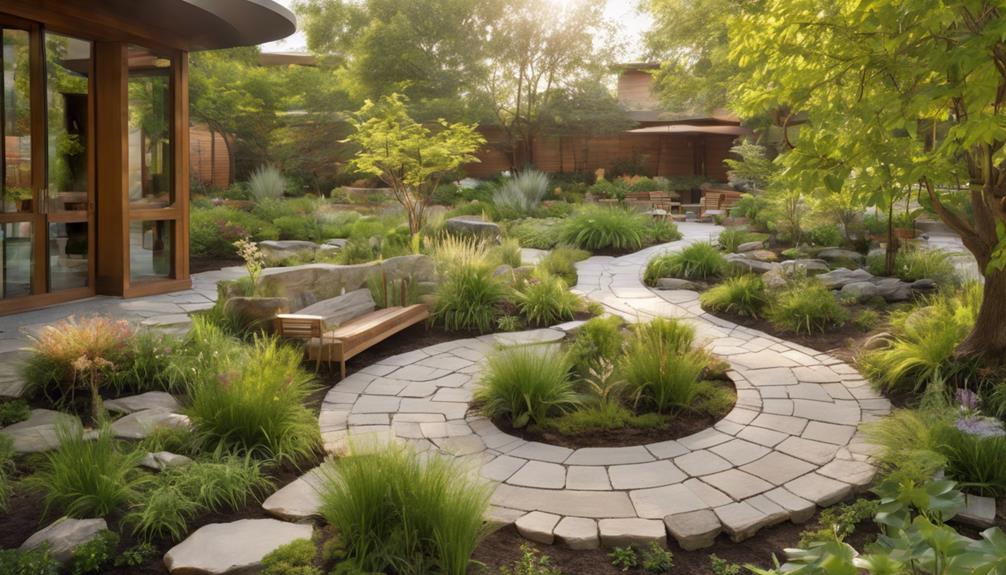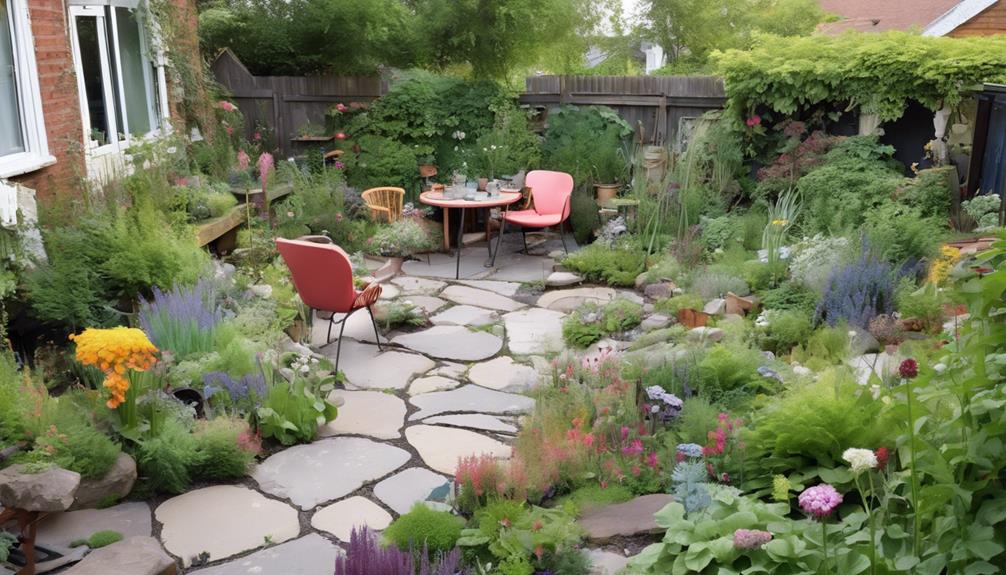
How to Design Biodiverse Gardens With Native Plants
17 September 2024
Designing Gardens for Mental Wellness Benefits
18 September 2024The three key elements of therapeutic garden design include purpose and functionality, thoughtful plant selection, and accessibility features.
Purposeful design creates serene spaces that promote healing and foster social interaction. Careful selection of plants emphasises native species, sensory engagement, and ecological compatibility, enhancing the garden's therapeutic qualities.
Accessibility features allow individuals of all abilities to fully engage with the garden, ensuring inclusivity and comfort.
These elements collectively contribute to creating effective environments for reflection and emotional well-being.
Investigate further aspects of therapeutic gardens to understand their profound impact on holistic health and well-being.
Garden Design Fundamentals
Garden design fundamentals are essential for creating spaces that effectively serve therapeutic purposes.
Understanding the specific goals and functionality of a garden enables informed decisions on plant selection strategies that enhance the overall experience.
Purpose and Functionality
Creating therapeutic garden spaces involves understanding their purpose and functionality, which are essential for fostering healing and well-being.
These gardens serve multiple roles, including providing a serene environment for reflection, encouraging physical activity, and facilitating social interaction. A well-designed therapeutic garden can improve emotional resilience and reduce stress through sensory engagement with nature.
Specific features, such as pathways, seating areas, and water elements, must be thoughtfully integrated to promote accessibility and comfort. Additionally, the layout should accommodate diverse activities, from quiet contemplation to group gatherings, ensuring inclusivity.
Plant Selection Strategies
Effective therapeutic garden design relies heavily on thoughtful plant selection strategies to enhance the overall healing experience. Selecting plants involves a thorough understanding of their sensory attributes, therapeutic benefits, and ecological compatibility.
Prioritise native species that promote biodiversity and require minimal maintenance, ensuring sustainability. Consider plants with varied textures, colours, and fragrances to engage multiple senses, thereby enhancing emotional and psychological well-being.
Incorporate medicinal herbs to provide educational opportunities and potential therapeutic uses. Furthermore, assess seasonal variations to ensure year-round interest and accessibility.
The careful curation of plants should also take into account the specific needs of users, including those with sensory sensitivities or mobility challenges.
Ultimately, strategic plant selection fosters an inclusive environment conducive to healing and personal growth.
Plant Selection Criteria
Effective plant selection is vital in therapeutic garden design, as it directly impacts the garden's comprehensive benefits.
Criteria such as the suitability of native plants, the integration of accessibility features, and the enhancement of sensory experiences must be carefully considered to create a welcoming and restorative environment.
Native Plant Suitability
When selecting native plants for therapeutic gardens, it is essential to consider several key criteria that ensure their suitability for both ecological and therapeutic purposes.
The chosen plants must not only thrive in their environment but also contribute positively to the healing experience.
Key criteria include:
- Ecological Compatibility: Verify that plants are suited to local soil and climate conditions.
- Sensory Engagement: Select species that engage multiple senses through flowers, scents, and textures.
- Maintenance Requirements: Choose low-maintenance varieties to ensure sustainability and ease of care.
- Biodiversity Support: Incorporate plants that attract pollinators and support local wildlife.
- Cultural Relevance: Consider native plants that have historical or cultural significance to the community.
These criteria will optimise the therapeutic garden's impact and resilience.
Accessibility Features Integration
Incorporating accessibility features into therapeutic garden design is crucial for ensuring that all individuals can engage with and benefit from the natural environment.
Thoughtful plant selection criteria can enhance accessibility, allowing diverse users to thrive in these spaces.
Key considerations for plant selection include:
- Height Variation: Incorporate low-growing plants for visibility and ease of access.
- Tactile Elements: Select species with varied textures to stimulate touch.
- Seasonal Interest: Choose plants that provide visual appeal throughout the year.
- Fragrance: Integrate aromatic plants to enhance the sensory experience for individuals with visual impairments.
- Non-Toxicity: Prioritise plants that are safe for individuals, including children and pets.
These criteria help create an inclusive environment that fosters well-being and connection to nature.
Sensory Experience Enhancement
To enhance the sensory experience within therapeutic gardens, careful attention must be given to plant selection criteria that engage multiple senses.
By thoughtfully choosing plants, designers can create immersive environments that promote well-being and tranquillity.
Key considerations include:
- Aromatic Qualities: Select fragrant herbs and flowers to stimulate olfactory senses.
- Textural Variety: Incorporate plants with diverse leaf shapes and textures for tactile exploration.
- Colour Diversity: Utilise a vibrant colour palette to visually stimulate and uplift visitors.
- Auditory Elements: Include plants that produce sound, such as rustling leaves or seed pods, improving auditory experiences.
- Seasonal Interest: Choose plants that offer year-round sensory engagement, ensuring continuous interaction with the environment.
These criteria collectively foster a holistic sensory experience, essential for the effectiveness of therapeutic gardens.
Designing for Diverse Abilities
Designing therapeutic gardens for different abilities begins with an initial site assessment to identify accessibility challenges and opportunities for inclusive design.
Enhancing soil quality through various improvement techniques ensures that all plants thrive, creating a welcoming environment for all users.
Furthermore, integrating therapeutic water features can provide sensory experiences while promoting relaxation and engagement among visitors with differing needs.
Initial Site Assessment
A thorough initial site assessment is crucial for creating a therapeutic garden that accommodates diverse abilities. This process involves evaluating the site's characteristics to ensure accessibility, safety, and sensory engagement for all users.
Key considerations during this assessment include:
- Topography: Identify slopes and uneven surfaces that may hinder access.
- Pathways: Evaluate existing paths for width, surface material, and navigability for wheelchairs and mobility aids.
- Sunlight: Assess sunlight exposure throughout the day to support plant selection and user comfort.
- Water Access: Determine proximity to water sources for irrigation and user convenience.
- Surrounding Environment: Analyse noise levels and visual distractions that may impact relaxation and focus.
Soil Quality Improvement Techniques
Improving soil quality is a fundamental aspect of creating a therapeutic garden that supports the diverse needs of users. Effective soil management enhances plant health and accessibility, ensuring that all individuals, regardless of ability, can engage with the garden.
Implementing specific techniques can markedly enrich the soil environment:
- Composting: Integrating organic matter to increase nutrient content.
- Mulching: Applying surface materials to retain moisture and suppress weeds.
- Soil testing: Regularly evaluating pH and nutrient levels to inform amendments.
- Raised beds: Designing elevated planting areas to facilitate easier access for those with mobility challenges.
- Cover crops: Utilising specific plants to improve soil structure and health during off-seasons.
These techniques create a foundation for a flourishing therapeutic garden that benefits all users.
Therapeutic Water Features Integration
Incorporating therapeutic water features into garden designs can significantly enhance the sensory experience for users of all abilities. Thoughtfully designed water elements not only promote relaxation but also enhance accessibility.
To achieve this, consider the following strategies:
- Adjustable height features: Ensure water elements can be enjoyed from various vantage points, including seating areas.
- Gentle soundscapes: Select features that produce soft, soothing sounds to create a calming atmosphere.
- Textured surfaces: Use a range of textures around water features to engage users through touch.
- Visual contrast: Incorporate colours and materials that stand out, aiding visually impaired individuals in navigation.
- Safety measures: Design barriers or shallow waters to minimise risks for users with mobility challenges.
These considerations foster an inclusive, therapeutic environment.
Emotional Well-Being Enhancement
Through the careful integration of sensory elements and natural features, therapeutic garden design can significantly enhance emotional well-being. By engaging the senses, these gardens cultivate tranquillity, alleviate stress, and foster a sense of belonging. Key components include varied plant textures, vibrant colours, and soothing sounds, which collectively create an immersive experience.
| Element | Impact on Emotional Well-Being | Implementation Strategy |
|---|---|---|
| Aromatic Plants | Boosts mood and relaxation | Incorporate herbs and flowers |
| Textural Diversity | Stimulates tactile engagement | Use varied foliage and surfaces |
| Sound Features | Reduces anxiety through nature | Integrate water features or wind chimes |
| Colour Psychology | Influences emotions | Select palettes that evoke calm |
| Open Spaces | Encourages social interaction | Design areas for gathering |
Incorporating these elements can greatly enhance emotional resilience and overall mental health.
Therapeutic Plant Care Programs
Therapeutic Plant Care Programmes play an essential role in promoting mindfulness and emotional well-being through gardening activities.
These programmes often incorporate group therapy gardening sessions that foster social connections and support among participants.
Furthermore, community gardening initiatives create opportunities for collaboration and shared experiences, enhancing overall mental health and resilience.
Mindfulness Through Gardening Activities
Gardening activities offer a unique opportunity for individuals to engage in mindfulness, fostering a deeper connection with nature and themselves. Through the practice of therapeutic plant care, participants cultivate not only plants but also awareness and presence in the moment.
This intentional focus can enhance emotional well-being and promote a sense of tranquillity.
Key mindfulness benefits of gardening include:
- Improved sensory awareness: Engaging with textures, colours, and scents promotes present-moment awareness.
- Reduction of stress: The rhythmic nature of gardening can lower cortisol levels and diminish anxiety.
- Emotional regulation: Nurturing plants encourages self-reflection and emotional processing.
- Increased focus: Concentrating on gardening tasks sharpens attention and reduces distractions.
- Physical connection: Soil and plant interaction fosters a tangible relationship with the environment.
Group Therapy Gardening Sessions
Group therapy gardening sessions combine the benefits of mindfulness with the power of community, creating a supportive environment for participants to engage in therapeutic plant care.
These sessions foster emotional well-being and promote social interaction while nurturing a shared connection to nature.
Key elements of successful group therapy gardening include:
- Structured Activities: Organised tasks that encourage participation and skill development.
- Guidance from Professionals: Support from horticultural therapists to facilitate meaningful experiences.
- Focus on Mindfulness: Techniques to improve present-moment awareness during gardening tasks.
- Emotional Expression: Opportunities to share feelings and experiences related to personal growth and healing.
- Collaborative Goals: Collective objectives that instil a sense of purpose and achievement among participants.
Through these components, group therapy gardening sessions improve both individual and communal healing.
Community Gardening Initiatives
Community gardening initiatives serve as crucial platforms for therapeutic plant care programmes, fostering connections among individuals while enhancing mental and physical well-being.
These initiatives create inclusive environments where participants engage in horticultural activities that promote healing and community cohesion.
Key benefits of community gardening initiatives include:
- Enhanced Social Interaction: Encourages collaboration and communication among diverse groups.
- Physical Activity: Provides opportunities for exercise, improving general health.
- Mental Well-Being: Reduces stress and anxiety through immersion in nature.
- Skill Development: Offers educational experiences in gardening and sustainability.
- Food Security: Contributes to local food sources, promoting nutritional health.
Maintenance and Sustainability Issues
Effective maintenance and sustainability in therapeutic garden design require a focus on soil erosion mitigation strategies, which are essential for preserving soil health and structure.
Furthermore, incorporating adaptive gardening tools can improve accessibility and ease of maintenance for diverse populations.
Soil Erosion Mitigation Strategies
How can therapeutic garden designs effectively address soil erosion while promoting sustainability?
Integrating specific strategies into the garden design can significantly reduce soil erosion and enhance ecological balance. Employing these methods not only preserves soil integrity but also fosters a resilient environment for therapeutic benefits.
- Utilise native plants with deep root systems to stabilise soil.
- Implement contour planting to align with the landscape's natural flow.
- Create terraced gardens to reduce runoff and encourage water retention.
- Incorporate mulch and ground cover to protect soil from erosion.
- Design rain gardens to capture and manage stormwater effectively.
These strategies not only mitigate soil erosion but also contribute to the overall health of the garden, ensuring that the therapeutic space remains sustainable for years to come.
Incorporating Adaptive Gardening Tools
Incorporating adaptive gardening tools is essential for ensuring that therapeutic gardens remain accessible and sustainable for all users, particularly those with physical limitations.
These tools not only improve user engagement but also facilitate ongoing maintenance, promoting a sustainable gardening environment. Effective integration of adaptive tools can greatly reduce barriers to participation and empower individuals to cultivate their gardening skills.
- Ergonomic hand tools to minimise strain
- Raised garden beds to reduce bending
- Tool grips designed for limited dexterity
- Wheelchair-accessible planting areas
- Self-watering systems to ease irrigation tasks
Seasonal Plant Rotation Strategy
A well-planned seasonal plant rotation strategy is crucial for maintaining the health and productivity of therapeutic gardens while addressing sustainability issues.
Implementing this strategy enhances soil fertility, reduces pest and disease pressures, and promotes biodiversity.
Key considerations include:
- Varied Plant Selection: Incorporate different species to improve soil health and attract beneficial organisms.
- Crop Rotation: Alternate plant families to disrupt pest life cycles and prevent nutrient depletion.
- Seasonal Timing: Schedule planting and harvesting to optimise growth cycles and seasonal climate conditions.
- Soil Health Monitoring: Regularly assess soil conditions to adapt planting strategies and improve sustainability.
- Resource Management: Utilise rainwater harvesting and composting to minimise environmental impact.
Effectively managing these elements guarantees the long-term viability and therapeutic benefits of garden spaces.
Why Choose TKL Birmingham Gardener
Choosing TKL Birmingham Gardener for your therapeutic garden design ensures a seamless integration of expertise and passion.
Our team possesses extensive knowledge in horticultural therapy and landscape design, guaranteeing that each element of your garden plays a meaningful role in promoting well-being. We prioritise a holistic approach, incorporating sensory experiences, accessibility, and ecological sustainability into our designs.
Our skilled gardeners are proficient in selecting plants that not only flourish in your specific environment but also enhance the therapeutic qualities of your space.
Furthermore, we collaborate closely with clients to customise designs that reflect individual needs and aspirations.
Gardening Benefits for Mental Health
Numerous studies have demonstrated that gardening offers significant benefits for mental health, serving as a powerful tool for stress reduction and emotional well-being.
Engaging in horticultural activities fosters mindfulness, allowing individuals to immerse themselves in the present moment, thereby alleviating anxiety and depressive symptoms. The physical activity involved in gardening releases endorphins, improving mood and promoting a sense of achievement.
In addition, nurturing plants cultivates a connection to nature, which can mitigate feelings of isolation and enhance overall life satisfaction. Social interactions within community gardens also foster a sense of belonging, which further supports mental health.
Consequently, incorporating gardening into therapeutic practices can be a highly effective strategy for boosting psychological resilience and promoting holistic wellness.
Future Gardening Workshops
Looking ahead, the implementation of future gardening workshops presents an exciting opportunity to enhance community engagement and promote mental well-being through hands-on horticultural experiences.
These workshops can serve as essential platforms for education, skill development, and therapeutic interaction. To optimise their impact, consider incorporating the following elements:
- Expert-Led Sessions: Engage horticulturalists and therapists to guide participants.
- Diverse Plant Selection: Introduce a variety of plants, including medicinal and sensory varieties.
- Mindfulness Practices: Integrate mindfulness techniques to enrich the therapeutic experience.
- Community Collaboration: Partner with local organisations to broaden participation and resources.
- Follow-Up Programmes: Establish ongoing support to foster sustained engagement and learning.
Such workshops can greatly strengthen community ties while nurturing individual mental health.




